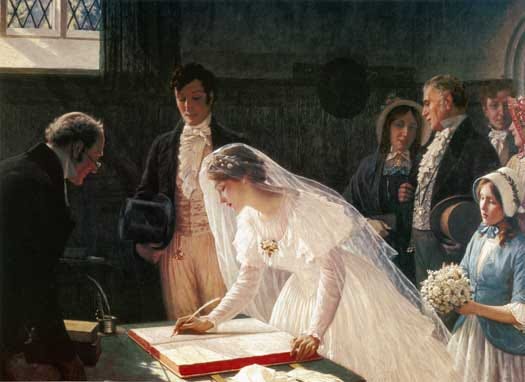Some wedding food traditions have endured through the ages while others follow social norms. Kim and Leigh discuss recipes with surprising ingredients, the symbolism of wedding foods, and ancient wedding favors.
Weddings mark a powerful moment of social change in our lives. Modern marriages cling to the concept of romantic, fated love but most marriages in human history were a function of declaring unions and partnerships between powerful families, even entire nations. Such important events were celebrated lavishly with feasts and several days of entertainment. Many wedding traditions endure today, particularly wedding cakes and wedding favors. Leigh and Kim check out these two wedding “must-haves” - wedding cakes and Jordan almonds, the perennial wedding favor.
A Slice for Sweetness
Leigh used to make cakes for all sorts of occasions and had this interesting perspective on the difference between a cake for a wedding and a cake for any other sort of celebration - the wedding cake is really the centerpiece of the reception. It's the first place that people migrate to in the reception hall, and it gives a glimpse into the couple's life together now, and maybe even into the future.
There's a lot of speculation around the origins of the wedding cake. And like so many origin stories, it really depends upon who you talk to, who you read, when it was written or even who has the political power.
The earliest recorded recipe in Britain specifically indicated for wedding ceremonies was called a bride's pie: a large round pie that was really ornately decorated. The filling consisted of oysters; pine kernels; cocks comb; lamb stones, which are testicles; sweetbreads, and spices. A lot of the ingredients were and still are considered aphrodisiac foods and spices during this time were really connected to affluence.
Another recipe found in The Art of Cookery Made Plain and Simple by Hannah Glass describes a cake meant for some kind of a huge celebration with four pounds of flour, 32 eggs, six pounds of dried fruit, a half a pint of Brandy, and a very unusual icing composed of double refined sugar, egg whites, orange flower water, musk, and ambergris - a very rare and highly coveted substance derived from the undigested beak of giant squid that surrounded by a secretion from the bile ducts as it passes through a sperm whale's digestive system. After being beaten for two hours, the icing is allowed to set into a hard shell that is pure white - symbolic of purity and virginal attributes - and clearly expensive denoting your status in society.
There was another speculation that the wedding cake was born in Victorian England when French confectionary skills influenced the popularity of fanciful cakes at all social occasions. Queen Victoria's wedding to Prince Albert in 1840 featured a multilayered cake decorated with two turtle doves, symbolizing, purity, and innocence, a dog symbolizing, faithfulness, cupids, and Britannia, the helmeted female warrior, who personified Britain itself white icing, which became known as Royal icing.
To Have and to Hold: Jordan Almonds
When Kim was preparing for this episode, she asked her friends which foods they thought were synonymous with weddings, besides cake. The answers, both funny and serious, included:
Punch with Sprite, juice, and sherbet
Chicken, dry chicken, or dry chicken or fish
Butter mints
Groom’s cake
Croque-en-bouche
Kugel or bagels & lox for a modern Jewish wedding
And… Jordan almonds.
Before research, Kim thought “Jordan almonds” were just pretty, pastel almonds from Jordan. What she learned however was that Jordan almonds actually belong to a special form of confectionery known as dragee (draz-ey) or confeti or koufeta or mlabas. In this form, the confectionery has a two-fold purpose; in addition to its basic consumption, it is also symbolic or medicinal or maybe even just decorative.
At their most basic, Jordan almond confectionery as a wedding favor represents the blending of bitterness and sweetness that often accompanies married life. Particularly at Italian and Greek weddings, they are presented in groups of five to represent happiness, health, longevity, wealth, and fertility and/or to represent the indivisibility of the couple.
Post-modern life has replaced the almond with all manners of trinkets and toys with novelty outpacing tradition. We may no longer revere the almond tree as a symbol of life, love, and happiness, and Kim wonders what is replacing it, and why.
Wedding Foods Transcript
🎧 Click here for the full, interactive transcript of this episode 🎧
Sources We Found Helpful for this Episode
Books We Think You’ll Enjoy Reading
The Accomplished Cook by Robert May
The Art of Cookery Made Plain and Simple by Hannah Glass
Brides and Bridals by John Cordy Jeaffreson
An A-Z of Food & Drink by John Ayto and Alan Davidson
Nectar and Ambrosia: An Encyclopedia of Food in World Mythology by Tamara Andrews
Candy: The Sweet History by Beth Kimmerle
Recipes You Really Need to Try
Jordan Almonds - food.com
White Wedding Cake - Pear Tree Kitchen
Episodes We Think You’ll Like
Grain Empires: The Wheat Belt, American Innovation, and A Kitchen Confidante
Kitchen Technologies: Salt Cellars, Automatons, and Coffee Filters
We would love to connect with you
AsWeEat.com, on Instagram @asweeat, join our new As We Eat community on Facebook, or subscribe to the As We Eat Journal.
Do you have a great idea 💡 for a show topic, a recipe 🥘 that you want to share, or just say “hi”👋🏻? Send us an email at connect@asweeat.com
Review As We Eat on Podchaser or Apple Podcast. We would like to know what you think.
And please subscribe to As We Eat, Going Places. Eric and Leigh will be traveling in their converted van sharing stories of food culture from the road.
We would love it if you would consider becoming a supporting subscriber. For just a few dollars, you can get access to exclusive content including our Recipe Box Roulette “card” game, more in-depth articles, more recipes and you’ll help keep our oven lights on!
Thank you for listening to the As We Eat Podcast. This post is public so share it with a friend - or three :)
























Wedding Foods